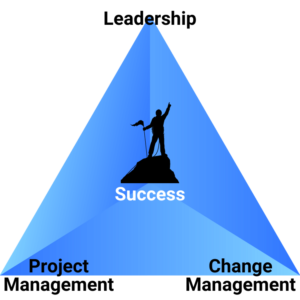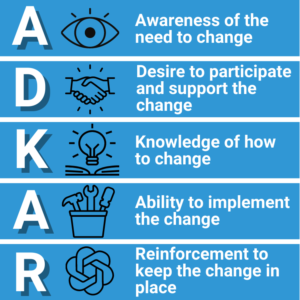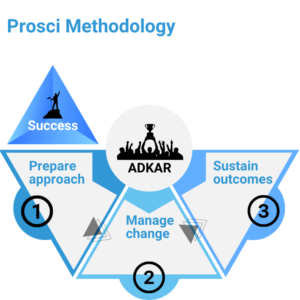
Change Management
The success or failure of an organizational change can often be determined by whether or not the right change management framework was put in place. Data shows that those who adopt change management strategies are more likely to achieve their project goals, adhere to timelines and budgets, and ultimately see the desired results. Without the right guidance and proactive planning, organizations can find themselves taking on more than they can handle, leading to delays, cost overruns, and frustration across the board. Change management is the key to unlocking the full potential of organizational changes and should be considered an integral part of any successful project.
Jari H. Helenius, Managing Partner, HKH Management Consulting
A methodical system for propelling organizational transformation
Organizational change is a critical factor in staying competitive, but it can be difficult to manage. It can be approached multiple ways deploying various methodologies. While our change project management toolkit includes various methodologies and frameworks, such as Audience Identification Matrix, Change Lean Canvas, Change Commitment & Change Personal Transition Curves, Change Impact Assessment & Matrix, Innovation Adoption Curves, and many others, Prosci has developed maybe the most versatile and effective of frameworks for change management – the Prosci Methodology, a comprehensive and structured approach to driving organizational change.
People at the core of the change
The success or failure of any change, whether it be the implementation of new technology or processes, ultimately comes down to how well it is embraced and adopted by the people affected by it. Organizations must recognize that, in order to successfully implement change, it is equally important to focus on the people side of the equation. A framework for managing the people side of change is essential to ensure successful outcomes. At its core, Prosci framework involves evaluating the impact that the proposed change will have on the individual, assessing the receptivity to the change, and then developing a plan that addresses the needs and concerns of those affected by it.
With a comprehensive plan in place, leaders can then ensure that each individual is equipped with the tools and resources needed to make the transition to the new system or process smooth and successful. By taking a proactive approach to managing the people side of change, organizations can ensure a successful outcome and maximize the potential for long-term success.
Discover more with our versatile change management toolkit how we can support your organization’s change journey


The Prosci Methodology
The Prosci Methodology is a comprehensive set of tools and processes for successful change management. It is comprised of three main components: the PCT Model, the ADKAR Model and the Prosci 3-Phase Process.
The PCT Model

The PCT Model is a simple yet powerful framework that helps to link the most important aspects of any change effort. It helps to systematically identify the components of change and how they fit together.
Let us know about your change management needs
Talk to usThe ADKAR Model

The ADKAR model was developed by Jeff Hiatt in 2003. It is a highly effective model to help individuals through the process of change. It provides guidance and support through the necessary elements to make the change.
Find out more how we can support your change efforts
Talk to usThe Prosci 3-Phase Process

The Prosci 3-Phase Process is a flexible framework to drive change at the organizational level. It provides a comprehensive, structured approach to ensure successful change management.
Contact to hear more how we can support in critical change efforts
Talk to usThe Prosci 3-Phase Process is composed of three phases—Prepare Approach, Manage Change, and Sustain Outcomes—each broken down into three stages. With this framework, change practitioners have the tools and guidance necessary to ensure that change initiatives are successful.
Whereas the ADKAR Model focuses on successful change at the individual level, the Prosci 3-Phase Process provides a powerful tool for achieving organizational change.
The Prosci 3-Phase Process is both structured and adaptable, allowing practitioners to tailor it to the needs of their organization or project. With the Prosci 3-Phase Process, organizations can ensure that they are equipped with the knowledge and skills needed to drive organizational change effectively.
Prosci phase I – Prepare Approach
At the outset of the Prosci 3-Phase Process, the first phase of preparation is essential for ensuring success. During this phase, change and project teams develop a customized and comprehensive strategy that positions their change for success. The three stages of this phase include Define Success, Define Impact, and Define Approach.

The Define Success stage helps practitioners establish precisely what they are trying to achieve. This is accomplished through activities such as developing a detailed change profile and defining what success on the project looks like.

The Define Impact stage focuses on how the change impacts individuals, using activities such as identifying impacted groups and defining adoption and usage.

Finally, the Define Approach stage sees practitioners consider what steps they will need to take to achieve project success. This includes activities such as assessing risk, identifying potential resistance, and establishing required roles.
At the conclusion of this phase, a Change Management Strategy is delivered that establishes the approach needed to deliver desired project outcomes. By following the Prosci 3-Phase Process and investing time in the preparation of the first phase, change and project teams are setting themselves up for success.
Prosci phase II – Manage Change
In the second phase of the Prosci 3-Phase Process, Change Management Strategy comes alive. This phase deals with developing plans and action to help individuals and organizations go through their ADKAR transitions. It comprises of three stages: Planning and Acting, Tracking Performance, and Adapting Actions.

The Planning and Acting stage focuses on preparing, equipping and supporting individuals who are impacted by the change. This includes activities such as developing an ADKAR Blueprint and Change Management Plans, like a Sponsorship Plan and Communication Plan.

The Tracking Performance stage focuses on monitoring and sustaining progress in the Change Management efforts. This includes activities such as creating a tracking calendar and identifying strengths and opportunities.

The Adaptive Action stage involves adjusting the Change Management Strategy based on what practitioners have learned. This includes activities such as preparing adaptive actions and continuing to track performance.
The ultimate deliverable of this phase is the Master Change Management Plan, which consolidates individual plans and serves as the guiding document for the Change Management team.
Prosci phase III – Sustain Outcomes
The Prosci 3-Phase Process is designed to ensure the successful adoption of change initiatives, with Phase 3 – Sustain Outcomes focused on ensuring that the change is adopted and the organization is committed to doing what’s needed to sustain it.

This phase consists of three distinct stages: Review Performance, Activate Sustainment, and Transfer Ownership. Through rigorous evaluation and implementation of key activities, practitioners are able to secure the change and ultimately achieve successful outcomes.
The result is a Change Management Closeout that documents the change performance status and prepares the organization for ownership and sustainability of the change initiative.

